View in other NatureServe Network Field Guides
NatureServe
Montana
Utah
Wyoming
Idaho
Wisconsin
British Columbia
South Carolina
Yukon
California
New York
Parasol Buckwheat - Eriogonum brevicaule var. canum
Other Names:
Rabbit Buckwheat,
Eriogonum lagopus, Eriogonum pauciflorum var. canum
State Rank Reason (see State Rank above)
Regional endemic taxa restricted in Montana to the Bighorn Basin/Pryor Mountain Desert area where it is locally abundant in some locality and is a dominant component of some vegetation communities. Trends are unknown, though likely stable.
- Details on Status Ranking and Review
Population Size
Score0-1 - Moderate to Large: Population size is imprecisely known but is believed to be >10,000 individuals.
Range Extent
Score3 - Local Endemic or Very Small Montana Range: Generally restricted to an area <10,000 sq. miles (equivalent to the combined area of Phillips and Valley Counties) or <6 Sub-basins (4th code watersheds) Range-wide OR limited to one Sub-basin in Montana
Area of Occupancy
Score1 - Moderate: Generally occurring in 11-25 Subwatersheds (6th Code HUC’s).
Environmental Specificity
Score0-1 - Low to Moderate.
Trends
Score0-1 - Stable to Minor Declines:
CommentTrends unknown, though populations are likely stable or experiencing only minor declines.
Threats
Score0-1 - Low to Medium.
Intrinsic Vulnerability
Score0-1 - Low to Moderate Vulnerability.
Raw Conservation Status Score
Score
4 to 9 total points scored out of a possible 19.
General Description
PLANTS: A tufted, perennial, up to 3 dm tall, with leaves and stems covered in white-wooly hairs. It has a branched, woody stem just below the soil surface (caudex). Source: Lesica et al. 2012.
LEAVES: Mostly basal, 1–3 cm long by 2-7 mm wide, linear to oblong (narrowly oblanceolate or spatulate), and covered with matted wooly hairs (tomentum). Source: Lesica et al. 2012.
INFLORESCENCE: Flowering stems are ascending to erect, 5–20 cm, and tomentose. The inflorescence is an open umbellate cyme, usually branching 3 or more times from a common base that has at least 2 scale-like bracts and sometimes a leaf. The involucre, which subtends the flowering pedicle, is wooly-hairy, 2-4 mm, with 5 united erect lobes. The flowers are comprised of 6 sparsely hairy yellow tepals (similar petals and sepals) with 9 exserted stamens. Tepals are 1-3 mm long. The flower is rounded at the base (cup-shaped) not tubular. Achenes are 2–3 mm long. Sources: Lesica et al. 2012; McGregor et al. 1986.
Montana plants belong to variety canum.
The name “Eriogonum” means hairy knees referring to the wooly nodes and stems (Giblin et al. [eds.] 2018). The specific name and variety mean “hairy, short-stem”, also pointing out the tomentum of the plant (Gledhill 1990).
Phenology
Flowering from June to September in Montana (
www.pnwherbaria.org).
Diagnostic Characteristics
Eriogonum is a diverse genus in south-central Montana, represented by at least 10 species. Most species have a tight inflorescence, some resembling a ball of flowers (e.g., E. ovalifolium, E. mancum, E. caespitosum, E. pauciflorum, and E. flavum) unlike the spreading-open flowering heads of Parasol Buckwheat. Three other species are annuals (E. annuum, E. cernuum, and E. salsuginosum). Parasol Buckwheat can be distinguished by the following combination of characteristics:
Parasol Buckwheat - Eriogonum brevicaule var. canum, PSOC
*Inflorescence: Spreading and open, not flat-topped.
*Flowers: Yellow, sparsely hairy (not glandular) sepals and petals (collectively called tepals). The tepals attach (connate) at their bases and are cup-shaped.
*Roots: A branched, woody caudex.
In the U.S. eight varieties of Eriogonum brevicaule are recognized (Reveal in FNA 2005). Variety canum is identified as having flowering stems and inflorescence branches covered with dense, soft, and interwoven hairs (tomentose) and tepals that are pubescent (though sparsely) (Reveal in FNA 2005).
Species Range
Montana Range
Range Descriptions
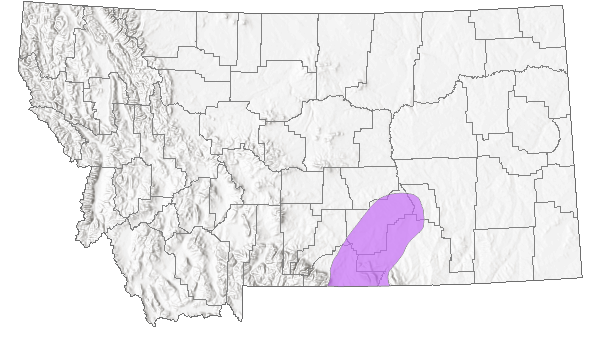
 Native
Native
Range Comments
On a global scale, Parasol Buckwheat is a regional endemic to south-central Montana and north-central Wyoming. It is widely scattered in the Big Horn Basin (Lesica and Achuff 1992). In Wyoming, it is known from the northern Big Horn Basin and the northeast and northwest flanks of the Big Horn Range (Big Horn, Park, and Sheridan counties) (https://wyndd.org/data_explorer.php). There is an extensive, contiguous population in the Bighorn Canyon National Recreation Area (Heidel and Fertig 2000). This species is limited in its distribution, however, where found populations are extensive.
Observations in Montana Natural Heritage Program Database
Number of Observations: 244
(Click on the following maps and charts to see full sized version)
Map Help and Descriptions
Relative Density
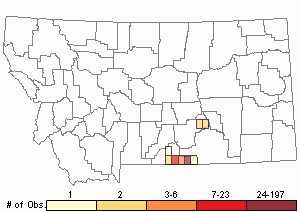
Recency
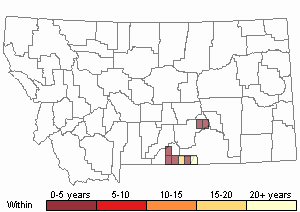
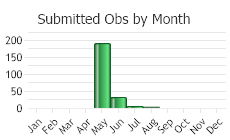
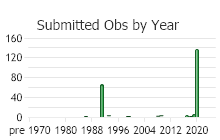
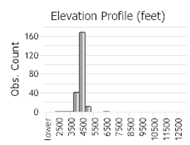 (Observations spanning multiple months or years are excluded from time charts)
(Observations spanning multiple months or years are excluded from time charts)
Habitat
Barren, calcareous, stony or clayey soils of badlands, exposed ridges, and slopes from valleys to the lower montane zone in Montana (Reveal in FNA 2005; Lesica et al. 2012).
In Wyoming, this species grows on barren slopes, terraces, and flats of Chugwater redbed clays, or reddish clay and dolomite gravel of the Goose Egg Formation. The setting is in cushion plant communities or openings in juniper woodland and sagebrush steppe (Fertig et al. 1994; Heidel and Fertig 2000).
Ecology
Parasol Buckwheat occurs in sparsely vegetated soils in mixed grasslands, sagebrush, and limber pine-juniper woodland communities.
ASSOCIATED PLANTSHerbarium specimens (
www.pnwherbaria.org) listed many plants as occurring with Parasol Buckwheat: Low Sagebrush (
Artemisia arbuscula), Longleaf Wormwood (
Artemisia longifolia), Big Sagebrush (
Artemisia tridentata), Summer Milkvetch (
Astragalus hyalinus), Shadscale (
Atriplex confertifolia), Thread-leaved Sedge (
Carex filifolia), Cock’s-comb Cat’s-eye (
Crypthantha celosioides), Bluebunch Wheatgrass (
Elymus spicatus), Rubber Rabbitbrush (
Ericameria nauseoa), Broom Snakeweed (
Gutierrezia sarothrae), Basin Daisy (
Platyschkuhria integrifolia), and Black Greasewood (
Sarcobatus vermiculatus).
In Wyoming, Parasol Buckwheat is found to be associated with Rayless Tansy-aster (
Machaeranthera grindelioides), Hooker's Sandwort (
Eremogone hookeri), Stemless Four-nerved-daisy (
Hymenoxys acaulis), Summer Milkvetch (
Astragalus hyalinus), and Bluebunch Wheatgrass (
Elymus spicatus).
POLLINATORS The following animal species have been reported as pollinators of this plant species or its genus where their geographic ranges overlap:
Bombus bifarius,
Bombus centralis,
Bombus flavifrons,
Bombus huntii,
Bombus melanopygus,
Bombus mixtus,
Bombus ternarius,
Bombus occidentalis,
Bombus insularis, and
Bombus flavidus (Thorp et al. 1983, Koch et al. 2012, Williams et al. 2014).
Management
RESEARCH NATURAL AREAS and AREA OF CRITICAL ENVIRONMENTAL CONCERN PROGRAM
The Research Natural Area (RNA) program is a nationwide system created to protect a network of federally administered public lands established for the purpose of scientific research, maintaining biological diversity, and education (USFS 2014). The intent is to designate RNAs that represent the full array of North American ecosystems with their biological communities, habitats, natural phenomena, and geological and hydrological formations. These intact protected areas are managed to maintain their natural and primitive character with a minimum of human disturbance. Each RNA also serves as a baseline of ecological information that can be used to compare against other similar, yet managed ecological systems.
A type of RNA is the Area of Critical Environment Concern (ACEC). The ACEC program was established in the 1976 Federal Lands Policy and Management Act and is managed by the Bureau of Land Management (BLM) (Wikipedia Contributors 2020). Places designated as ACECs require special management to protect important historical, cultural, and scenic values, fish and wildlife, or other natural resources (BLM 2021). The BLM has extended the purpose of RNAs to that of preserving gene pools of typical and endangered plants and animals (BLM 2015; BLM 2021).
Pryor Foothill RNA/ACEC
This RNA-ACEC was established in the Approved Resource Management Plan by the MT/Dakotas BLM, Billings Field Office, recommended for approval by the MT/Dakotas BLM State Director in 2015, and is awaiting final approval by the U.S Congress (BLM 2015). The RNA-ACEC is approximately 2,606 acres in size. The management goals for the Pryor Foothills RNA/ACEC are to protect a large concentration of BLM's special status plant species and rare plant communities (unique vegetation) and to protect significant historic and cultural values in the Gyp Springs area. With Parasol Buckwheat, populations are very common in the Pryor Foothill RNA-ACEC. Plants are frequently found outside of the RNA-ACEC where specific habitat is present in Carbon, Big Horn, and Yellowstone Counties. See Range Comments.
The area encompassing Gypsum Creek and Crooked Creek, which includes the present-day Pryor Foothill RNA/ACEC was recognized in 1991 as having the highest concentration of high-priority plant species' populations (Lesica and Achuff 1992). Surveys from the 1980's to 1990's found populations of eight rare species Astragalus geyeri, Astragalus oreganus, Camissonia andina, Cleome lutea, Grayia spinosa, Leptodactylon caespitosum, Malacothrix torreyi, and Mentzelia pumila, of which remain as either Montana Species of Concern or Potential Species of Concern. The area's concentration of unique and diverse plant species partially results from diverse habitats, terrain that varies from highly dissected foothills with deep canyons to broad alluvial valleys, and soils derived from calcareous standstone, Chugwater sandstone, and limestone. In their 1992 report the authors recommended that this area would serve as the best choice for a single reserve in the Pryor Mountain Desert (Lesica and Achuff 1992).
Stewardship Responsibility
Threats or Limiting Factors
In Montana, current and potential long-term threats to Parasol Buckwheat include (Lesica and Achuff 1992; Montana Native Plant Society 2009 and 2021):
Mining: Gypsum is a common mineral found in the Chugwater Formation. Gypsum claims have been made on public lands in vicinity of Parasol Buckwheat sites. Bentonite mining could occur in vicinity of other Parasol Buckwheat sites. Potential negative impacts from mining activities include direct removal and trampling of plants. Potential indirect negative impacts from mining activities include disturbance to habitat from soil erosion, soil compaction, and colonization by invasive species. Soils in the Chugwater Formation are known to be very susceptible to erosion.
Invasive Species: The arid landscape in which Parasol Buckwheat occurs is predominately in native, intact habitat. However, Cheatgrass (Bromus tectorum), African mustard (Malcolmia africans), and Halogeton (Halogeton glomeratus) are known to occur along roads near to some Parasol Buckwheat occurrences. Halogeton outcompetes many native species by increasing the salinity of the soil (Sauer 1988) and has become locally common in the Pryor Mountain Desert region (Lesica and Achuff 1992). There is the potential for negative impacts based on the assumption that these exotics would be more competitive for soil water and nutrient resources, thus displacing native plants.
Off-road Vehicle Recreation: Off-road vehicle (ORV) use commonly occurs further north in Pryor Mountains. In the Big Horn Canyon National Recreational Area one species occurrence grows along a road and may be vulnerable to vehicular disturbance. Where ORV use overlaps with Parasol Buckwheat populations there is the potential to damage plants by trampling, compacting soils, and increasing erosion. STATE THREAT SCORE REASON
Reported threats to Montana's populations of Parasol Buckwheat are due to multiple, likely interacting negative impacts in its roadside habitat (MTNHP Threat Assessment 2021).
References
- Literature Cited AboveLegend:
 View Online Publication
View Online Publication BLM Billings Field Office. 2015. Approved Resource Management Plan Appendices. Billings, MT: U.S. Department of the Interior Bureau of Land Management. 438 p.
BLM Billings Field Office. 2015. Approved Resource Management Plan Appendices. Billings, MT: U.S. Department of the Interior Bureau of Land Management. 438 p. Consortium of Pacific Northwest Herbaria (CPNWH) Specimen Database. No Date. Plant specimen data displayed on the PNW Herbaria portal. Website http://www.pnwherbaria.org.
Consortium of Pacific Northwest Herbaria (CPNWH) Specimen Database. No Date. Plant specimen data displayed on the PNW Herbaria portal. Website http://www.pnwherbaria.org. Fertig, W., C. Refsdal, and J. Whipple. 1994. Wyoming rare plant field guide. Wyoming Rare Plant Technical Committee, Cheyenne. No pagination.
Fertig, W., C. Refsdal, and J. Whipple. 1994. Wyoming rare plant field guide. Wyoming Rare Plant Technical Committee, Cheyenne. No pagination. Flora of North America Editorial Committee. 2005. Flora of North America North of Mexico. Volume 5. Magnoliophyta: Caryophyllidae: Caryophyllales, Polygonales, and Plumbaginales. New York, NY: Oxford Univ. Press. vii + 656 pp.
Flora of North America Editorial Committee. 2005. Flora of North America North of Mexico. Volume 5. Magnoliophyta: Caryophyllidae: Caryophyllales, Polygonales, and Plumbaginales. New York, NY: Oxford Univ. Press. vii + 656 pp. Gledhill, D. 1990. The names of plants. 2nd Ed. New York, NY: Cambridge University Press. 426 p.
Gledhill, D. 1990. The names of plants. 2nd Ed. New York, NY: Cambridge University Press. 426 p. Heidel, B.L. and W. Fertig. 2000. Rare plants of Bighorn Canyon National Recreation Area. Report to the National Fish and Wildlife Foundation and Bighorn Canyon National Recreation Area, National Park Service. Montana Natural Heritage Program and Wyoming Natural Diversity Database. Helena and Laramie. 63 pp. plus appendices.
Heidel, B.L. and W. Fertig. 2000. Rare plants of Bighorn Canyon National Recreation Area. Report to the National Fish and Wildlife Foundation and Bighorn Canyon National Recreation Area, National Park Service. Montana Natural Heritage Program and Wyoming Natural Diversity Database. Helena and Laramie. 63 pp. plus appendices. Hitchcock, C.L. and A. Cronquist. 2018. Flora of the Pacific Northwest: An Illustrated Manual. Second Edition. Giblin, D.E., B.S. Legler, P.F. Zika, and R.G. Olmstead (eds). Seattle, WA: University of Washington Press in Association with Burke Museum of Natural History and Culture. 882 p.
Hitchcock, C.L. and A. Cronquist. 2018. Flora of the Pacific Northwest: An Illustrated Manual. Second Edition. Giblin, D.E., B.S. Legler, P.F. Zika, and R.G. Olmstead (eds). Seattle, WA: University of Washington Press in Association with Burke Museum of Natural History and Culture. 882 p. Koch, J., J. Strange, and P. Williams. 2012. Bumble bees of the western United States. Washington, DC: USDA Forest Service, Pollinator Partnership. 143 p.
Koch, J., J. Strange, and P. Williams. 2012. Bumble bees of the western United States. Washington, DC: USDA Forest Service, Pollinator Partnership. 143 p. Lesica, P. and P.L. Achuff. 1992. Distribution of vascular plant species of special concern and limited distribution in the Pryor Mountain desert, Carbon County, Montana. Unpublished report to the Bureau of Land Management. Montana Natural Heritage Program, Helena, MT. 105 pp.
Lesica, P. and P.L. Achuff. 1992. Distribution of vascular plant species of special concern and limited distribution in the Pryor Mountain desert, Carbon County, Montana. Unpublished report to the Bureau of Land Management. Montana Natural Heritage Program, Helena, MT. 105 pp. Lesica, P., M.T. Lavin, and P.F. Stickney. 2012. Manual of Montana Vascular Plants. Fort Worth, TX: BRIT Press. viii + 771 p.
Lesica, P., M.T. Lavin, and P.F. Stickney. 2012. Manual of Montana Vascular Plants. Fort Worth, TX: BRIT Press. viii + 771 p. McGregor, R.L. (coordinator), T.M. Barkley, R.E. Brooks, and E.K. Schofield (eds). 1986. Flora of the Great Plains: Great Plains Flora Association. Lawrence, KS: Univ. Press Kansas. 1392 pp.
McGregor, R.L. (coordinator), T.M. Barkley, R.E. Brooks, and E.K. Schofield (eds). 1986. Flora of the Great Plains: Great Plains Flora Association. Lawrence, KS: Univ. Press Kansas. 1392 pp. MTNHP Threat Assessment. 2021. State Threat Score Assignment and Assessment of Reported Threats from 2006 to 2021 for State-listed Vascular Plants. Botany Program, Montana Natural Heritage Program, Helena, Montana.
MTNHP Threat Assessment. 2021. State Threat Score Assignment and Assessment of Reported Threats from 2006 to 2021 for State-listed Vascular Plants. Botany Program, Montana Natural Heritage Program, Helena, Montana. Thorp, R.W., D.S. Horning, and L.L. Dunning. 1983. Bumble bees and cuckoo bumble bees of California (Hymenoptera: Apidae). Bulletin of the California Insect Survey 23:1-79.
Thorp, R.W., D.S. Horning, and L.L. Dunning. 1983. Bumble bees and cuckoo bumble bees of California (Hymenoptera: Apidae). Bulletin of the California Insect Survey 23:1-79. USDA Forest Service. 2014. Research Natural Areas. Accessed 4 February 2021. https://www.nrs.fs.fed.us/rna/
USDA Forest Service. 2014. Research Natural Areas. Accessed 4 February 2021. https://www.nrs.fs.fed.us/rna/ USDI Bureau of Land Management. 2021. Areas of critical environmental concern. Accessed January 28, 2021. https://www.blm.gov/programs/planning-and-nepa/planning-101/special-planning-designations/acec
USDI Bureau of Land Management. 2021. Areas of critical environmental concern. Accessed January 28, 2021. https://www.blm.gov/programs/planning-and-nepa/planning-101/special-planning-designations/acec Wikipedia contributors. 2020. Area of critical environmental concern. Wikipedia, The Free Encyclopedia. Accessed 27 January 2021. https://en.wikipedia.org/w/index.php?title=Area_of_Critical_Environmental_Concern&oldid=994305208
Wikipedia contributors. 2020. Area of critical environmental concern. Wikipedia, The Free Encyclopedia. Accessed 27 January 2021. https://en.wikipedia.org/w/index.php?title=Area_of_Critical_Environmental_Concern&oldid=994305208 Williams, P., R. Thorp, L. Richardson, and S. Colla. 2014. Bumble Bees of North America. Princeton, NJ: Princeton University Press. 208 p.
Williams, P., R. Thorp, L. Richardson, and S. Colla. 2014. Bumble Bees of North America. Princeton, NJ: Princeton University Press. 208 p. Wyoming Natural Diversity Database. Offering the most complete information for species and habitats of conservation concern. Accessed 12 March 2021. https://wyndd.org/data_explorer
Wyoming Natural Diversity Database. Offering the most complete information for species and habitats of conservation concern. Accessed 12 March 2021. https://wyndd.org/data_explorer
- Additional ReferencesLegend:
 View Online Publication
View Online Publication
Do you know of a citation we're missing? Lesica, P. and P.L. Achuff. 1992. Conservation status of Eriogonum X Lagopus in southern Carbon County, Montana. Unpublished report to the Bureau of Land Management. Montana Natural Heritage Program, Helena, MT. 19 pp.
Lesica, P. and P.L. Achuff. 1992. Conservation status of Eriogonum X Lagopus in southern Carbon County, Montana. Unpublished report to the Bureau of Land Management. Montana Natural Heritage Program, Helena, MT. 19 pp. Lesica, P., M.T. Lavin, and P.F. Stickney. 2022. Manual of Montana Vascular Plants, Second Edition. Fort Worth, TX: BRIT Press. viii + 779 p.
Lesica, P., M.T. Lavin, and P.F. Stickney. 2022. Manual of Montana Vascular Plants, Second Edition. Fort Worth, TX: BRIT Press. viii + 779 p. Sauer, J.D. 1988. Plant migration: The dynamics of geographic patterning in seed plant species. Berkeley, CA: University of California Press. 298 p.
Sauer, J.D. 1988. Plant migration: The dynamics of geographic patterning in seed plant species. Berkeley, CA: University of California Press. 298 p.
- Web Search Engines for Articles on "Parasol Buckwheat"





